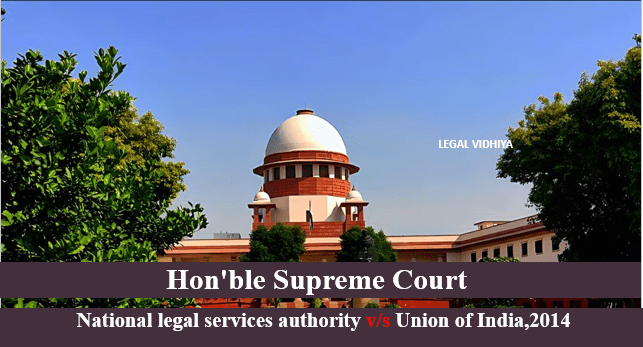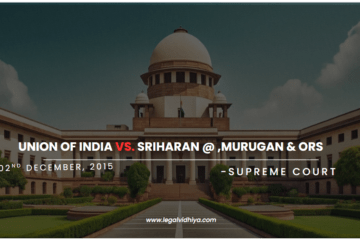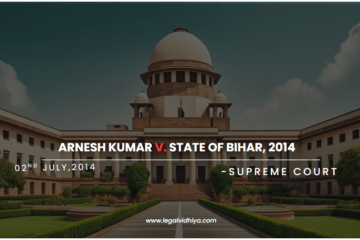
| NAME OF THE CASE | National Legal Services Authority v. Union of India |
| CITATION | AIR 2014 SC 1863; (2014) 5 SCC 438 |
| DATE OF THE JUDGEMENT | April 15, 2014 |
| APPELLATE | National Legal Services Authority |
| RESPONDENT | Union of India |
| BENCH/JUDGE | K.S. Radhakrishnan and A.K. Sikri |
Statue referred :
- Article 14, 15,16,19,21 of the Indian constitution.
- India Legal Services Authority Act, 1997
- Section 377 of The Indian Penal Code, 1860
Introduction-
Defining ‘transgender’:
- “Transgender” is typically defined as an umbrella term for individuals whose gender identity, gender expression, or behavior does not align with their biological sex. In a judgment rendered by the Madras High Court, the NALSA judgment has been interpreted as applicable primarily to individuals in the male-to-female transgender spectrum, potentially excluding a significant number of transgender individuals in the female-to-male category from the judgment’s purview. However, it’s worth noting that the Madras High Court also expresses the opinion that female-to-male transgender individuals should also possess the right to determine their gender.
Facts of the case-
- A petition was submitted to the Supreme Court of India by the National Legal Services Authority (NALSA) on behalf of the transgender community. This petition aimed to secure legal recognition and safeguard their rights. The primary question raised in this case revolved around the recognition of transgender individuals as a third gender and the provision of legal protections under the Indian Constitution. The petitioner contended that the transgender community encountered discrimination and marginalization across various aspects of life, encompassing education, employment, healthcare, and housing
Issue:
- Should transgender individuals be granted recognition as a third gender and provided with legal protection under the Indian Constitution?
- Is there a need to acknowledge the transgender community as the “Third Gender”?
Arguments:
The Petitioner contended that
- Discrimination and marginalization are experienced by the transgender community across various aspects of life, encompassing education, employment, healthcare, and housing.
- Legal recognition and protection are lacking for the transgender community, and the Indian Constitution inadequately addresses their rightsThe current legal framework’s binary gender classification, distinguishing between male and female, fails to encompass the rich tapestry of gender identities and expressions in India, leaving transgender individuals devoid of legal safeguards.
- Advocating for the recognition of the transgender community as a third gender, with corresponding legal protection under the Indian Constitution.
- Discrimination against transgender individuals amounts to a breach of their fundamental rights enshrined in the Indian Constitution, including the right to equality, dignity, and freedom from discrimination.
- Asserting that the Indian government has not taken sufficient measures to combat the discrimination and marginalization faced by the transgender community, necessitating the court’s intervention to safeguard their rights.
These contentions laid the foundation for NALSA’s petition in the Supreme Court of India and were pivotal issues addressed in the court’s historic judgment in this case.
The Respondent maintained the following objections that
- The Constitution of India currently furnishes ample protection and upholds fundamental rights for all citizens, including transgender individuals.
- The necessity of the binary gender classification, distinguishing between male and female, is primarily for administrative convenience, as introducing a third gender category could potentially lead to confusion and practical complexities.
- While being a relatively small and socially marginalized group, the transgender community’s specific legal recognition and rights protection might be perceived as unnecessary.
- In addressing the issues faced by the transgender community, the Indian government has already initiated measures such as reservations in education and employment. Further actions, if any, should be undertaken after thorough consideration and consultation.
- Establishing a separate gender category exclusively for transgender individuals in official documents is deemed unfeasible and redundant. Their identity can adequately be acknowledged using the existing male or female categories.
- These arguments were presented by the respondent during the case’s proceedings and were taken into account by the Supreme Court of India when delivering its verdict. Nevertheless, the court ultimately dismissed the respondent’s contentions and upheld the petitioner’s stance, asserting that the transgender community should indeed be recognized as a third gender and granted legal protection under the Indian Constitution.
- During the proceedings, Rakesh K. Khanna, a distinguished Additional Solicitor General representing the Union of India on the respondent’s side, emphasized the sensitivity of the issues raised by the transgender community, highlighting the need for serious attention.
- He informed the court that the Ministry of Social Justice and Empowerment had convened an Expert Committee to investigate matters concerning the transgender community and the challenges they encounter.
- Furthermore, he assured that adequate representation would be granted to the applicants who appeared before the Court in this Committee, ensuring that their perspectives are heard and suitable actions are taken.
- Khanna also acknowledged the efforts made by learned counsel representing various States and Union Territories to enhance the circumstances and standing of transgender community members in their respective regions.
Judgment:
- The year 2014 marked a significant turning point in terms of the legal acknowledgment of transgender individuals as bearers of citizenship and rights.
- To begin with, in January, a report on ‘matters related to transgender individuals’ was issued by the Ministry of Social Justice and Empowerment (MSJE). This report had been crafted by an ‘expert committee’ that MSJE had assembled following consultations with representatives from the transgender community in 2013.
- Subsequently, in April, a judgment was handed down by the Supreme Court following a writ petition submitted by NALSA (the National Legal Services Authority), with the backing of prominent transgender activists like Lakshmi Narayan Tripathi. The NALSA verdict, which garnered swift media attention and activist support, encompassed directives for the legal acknowledgment of transgender individuals’ identities and the establishment of reservations in jobs and education.
- In September 2014, MSJE followed up with an “Application for clarification/modification” submitted to the Supreme Court. This application aimed to elucidate the consequences of the judgment concerning the recommendations put forth by the aforementioned expert committee.
- The court also affirmed the right of transgender individuals to self-identification and asserted that gender identity constitutes an integral facet of one’s identity, beyond mere biological factors. The court instructed the government to grant legal recognition of gender identity to transgender people and ensure that they do not suffer discrimination based on their gender identity.
- In summary, the NALSA vs. Union of India verdict represented a significant stride forward in the recognition and safeguarding of transgender rights in India. It has paved the way for more extensive legal recognition and protection for transgender individuals, while also contributing to increased social acceptance and inclusivity for this marginalized community.
Conclusion:
“Transgender rights are a testament to India’s commitment to diversity and pluralism and we must strive to create a society where everyone can live authentically and without fear.”
- The judgment also entailed government action to address the discrimination and marginalization experienced by the transgender community, ensuring their access to fundamental rights and opportunities. This case significantly heightened awareness regarding the discrimination and marginalization confronted by transgender individuals in India, catalyzing endeavors to tackle these issues through policy changes and social transformation.
- It’s a remarkable achievement to witness the establishment of a distinct gender category for transgender individuals. However, this community still faces substantial challenges in altering societal mindsets. While this legal victory is significant, it’s just a small step on a long journey. Guari Sawant, who identifies as Hijra and rejects conventional gender labels, emphasized that changing people’s perceptions is an ongoing process. She expressed, “The law has recognized us as transgender. It’s about who I am. I’m not an alien.” Amidst the ongoing struggle for transgender rights, she finds solace in life’s simple joys.
- In conclusion, it’s essential to reflect on our preamble, which commences with “We the people of India” without highlighting any specific gender, asserting equality for all genders under the law.
- In July 2014, Sumi Das, the secretary of Moitrisanjog Coochbehar, a community-based organization collaborating with transgender kothi and hijra communities in West Bengal’s Coochbehar district, expressed criticism on Facebook. She highlighted the exclusionary nature of state-level consultations in West Bengal regarding transgender and hijra issues. Das pointed out that many smaller organizations in towns were overlooked during these consultations. She criticized the tendency for the state, influential NGOs, and activists to determine who qualifies as ‘transgender,’ often resulting in the neglect of less privileged and rural communities in state initiatives. Das’s post cautioned against political rivalry and competition concerning which transgender individuals would be included on state transgender welfare boards or committees. This critique, originating from within the affected community, serves as an essential warning against some of the risks associated with relying solely on legal and governmental mechanisms for inclusion and citizenship. It is hoped that transgender, hijra, and kothi communities will continue to challenge and strive beyond the government and legal systems’ adjudication and management of transgender identity while asserting their rightful claims to citizenship, rights, and recognition.
Drafted by: Jhalak Varshney, Lloyd Law college, Greater Noida, an intern legal vidhiya.




0 Comments